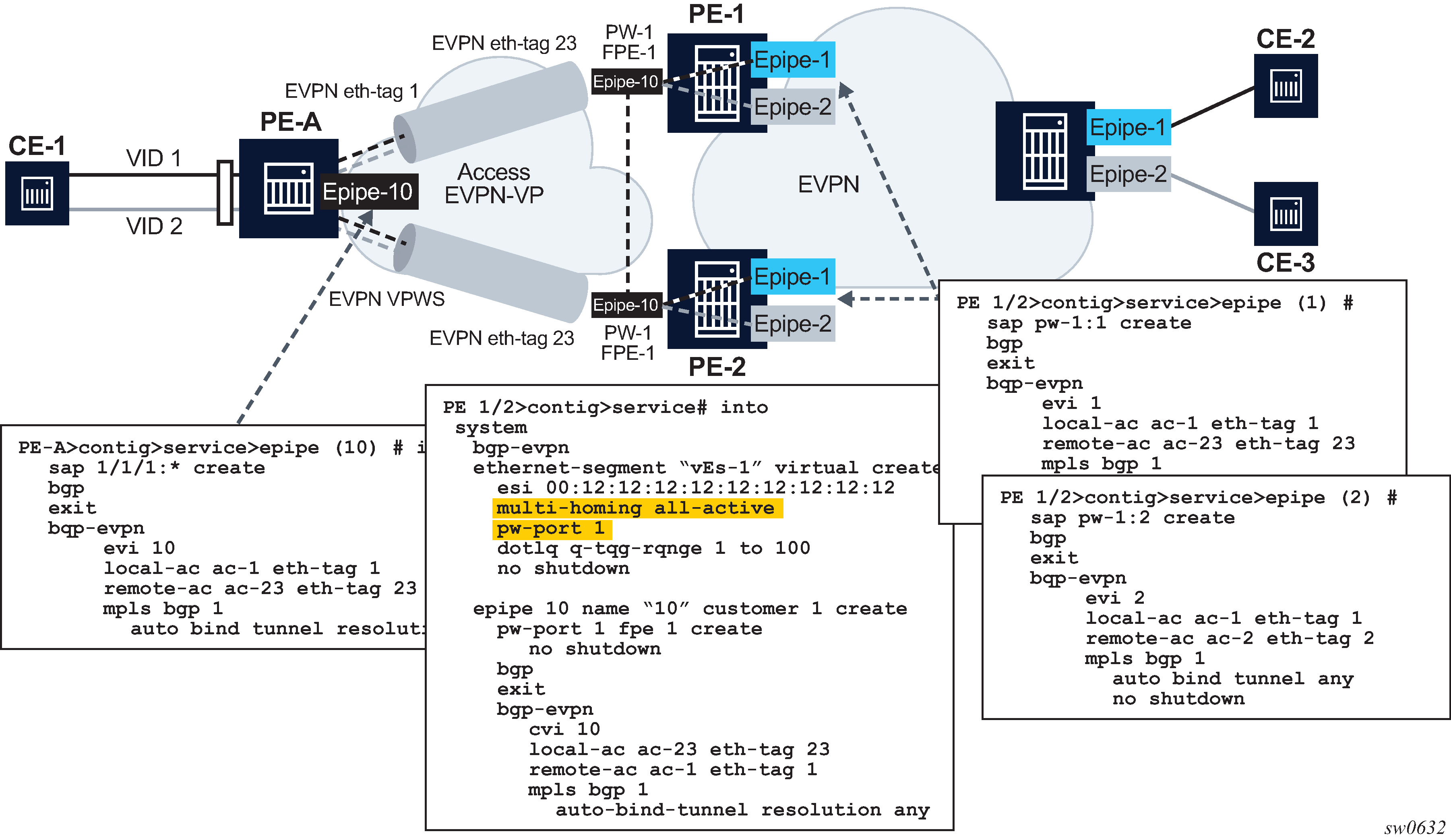PW ports in ESs and virtual ESs (vESs) are supported for EVPN-VPWS MPLS services. In addition to lag, port and sdp objects, pw-port pw-port-id can be configured. PW-port based ESs support all-active mode only, and not single-active mode. The following statements apply:
Port-based or FPE-based pw-ports can be used in ESs
The pw-port scenarios supported along with ESs are as follows:
port-based pw-port
FPE-based pw-port, where the stitching service uses a spoke SDP to the access CE
FPE-based pw-port, where the stitching service uses EVPN-VPWS (MPLS) to the access CE
Note that EVPN-VPWS for VXLAN is not supported along with pw-ports.
For all the above scenarios, fault-propagation to the access CE only works in case of physical failures. Administrative shutdown of individual Epipes, PW-SAPs, Ethernet-segments or BGP-EVPN may result in traffic black-holes.
Figure 1 illustrates the use of pw-ports in ESs. In this example, an FPE-based pw-port is associated with the ES, where the stitching service itself uses EVPN-VPWS as well.

In this example, the following applies:
Redundancy is driven by EVPN all-active multi-homing. ES-1 is a virtual ES configured on the FPE-based PW port on PE-1 and PE-2.
The access network between the access PE (PE-A) and the network PEs (PE-1 and PE-2), uses EVPN-VPWS to backhaul the traffic. Therefore, PE-1 and PE-2 use EVPN-VPWS in the PW port stitching service, where:
PE-1 and PE-2 apply the same eth-tag configuration on the stitching service (Epipe 10).
Optionally PE-1 and PE-2 can use the same RD on the stitching service.
AD per-EVI routes for the stitching service eth-tags are advertised with ESI=0.
Forwarding in the CE-1 to CE-2/CE-3 direction, works as follows:
PE-A forwards traffic based on the selection of the best AD per-EVI route advertised by PE-1 and PE-2 for the stitching Epipe 10. This selection can be either BGP based if PE-2 and PE-3 use the same RD in the stitching service, or EVPN based if different RD is used.
When the PE-1 route is selected, PE-1 receives the traffic on the local PW-SAP for Epipe 1 or Epipe 2, and forwards it based on the customer EVPN-VPWS rules in the core.
Forwarding in the CE-2/CE-3 to CE-1 direction, works as follows:
PE-3 forwards the traffic based on the configuration of ECMP and aliasing rules for Epipe 1 and Epipe 2.
PE-3 can send the traffic to PE-2 and PE-2 to PE-A, following different directions.
If the user needs the traffic to follow a symmetric path in both directions, then the AD per-EVI route selection on PE-A and PE-3 can be handled so that the same PE (PE-1 or PE-2) is selected for both directions.
For this example, the solution provides redundancy in case of node failures in PE-1 or PE-2. However, the administrative shutdowns, configured in some objects, are not propagated to PE-A, leading to traffic black-holing. As a result, black-holes may be caused by the following events in PE-1 or PE-2:
Epipe 1 (or 2) service shutdown
Epipe 1 (or 2) BGP-EVPN MPLS shutdown
vES-1 shutdown
BGP shutdown